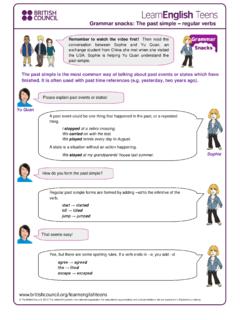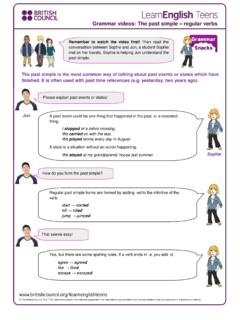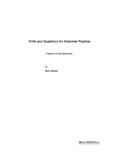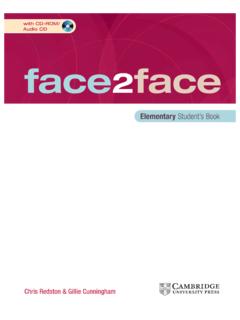Transcription of Pronunciation Practice final (2)
1 Pronunciation Practice - Lauren Osowski (2012) 1 Pronunciation Practice Games, activities, curriculum suggestions, and word lists to improve Pronunciation A mini-grant project by: Lauren Osowski ESOL Coordinator/Teacher Adult Learning Center Nashua, New Hampshire September 2012 Pronunciation Practice - Lauren Osowski (2012) 2 Table of Contents Introduction .. 4 Curriculum Suggestions .. 5 Word Lists .. 8 Short and long a .. 9 Short and long e .. 10 Short and long i .. 11 Short and long o .. 12 Short and long u .. 13 b and p sounds .. 14 b and v sounds .. 15 f and v sounds .. 16 l and r sounds.
2 17 s and z sounds .. 18 s , sh and ch sounds .. 19 j and y sounds .. 20 th sounds .. 21 s and th sounds .. 22 t and th sounds .. 23 d and t sounds .. 24 d and t sounds (past tense) .. 25 m and n sounds .. 26 Intonation and Stress .. 27 Linking .. 28 Games and Activities .. 29 Circle the Picture .. 30 Pronunciation Practice - Lauren Osowski (2012) 3 Games and Activities (cont.) Dominoes .. 32 Drawing Dictation .. 33 Intonation Dialogue .. 34 Magazine Search .. 37 Matching .. 38 Pair Dictation .. 39 Picture Sorting .. 41 Pronunciation Maze .. 42 Same or Different .. 45 Shadow Reading.
3 46 Slap and Clap .. 48 Stand up, Sit down .. 49 Story Reading .. 50 This and That .. 52 Tic Tac Toe .. 53 Vowel Smack Game .. 55 Vowel Sound Scavenger Hunt .. 56 Which one doesn t belong? .. 58 Additional Photocopiables .. 60 5 Tips for Proper english Pronunciation .. 61 10 Tips for Teachers: Help ESL students increase phonetic awareness and improve Pronunciation .. 62 Tongue Twisters .. 63 S, Sh and Ch Tongue Twisters .. 64 Pronunciation of Regular Past Tense Verbs .. 65 How do you pronounce it? .. 66 Typical Pronunciation Problems by Language Group .. 67 Pronunciation Practice - Lauren Osowski (2012) 4 Introduction When asked which area of english they would most like to improve, the majority of students will answer Pronunciation .
4 While it is nearly impossible to completely eliminate an accent, it is possible to reduce it and increase understandability. Doing so takes Practice , Practice , and more Practice . Imagine a runner, a sprinter. They may be an elite athlete who has trained for years to run 200 meters as fast as possible. However, if you ask that same athlete to run a marathon, they would need to re-train their muscles to handle the endurance, the different type challenge. It is the same process language learners go through to train their facial muscles to handle and new sounds. When an infant acquires their first language, their facial muscles are trained in a particular way to produce the specific sounds for their language.
5 As an adult, this language learner must re-train and manipulate their facial muscles to generate new sounds. Depending on the student s native language, exposure to the new language, listening capability and determination, this training can go smoothly and lead to understandability or be extremely difficult and lead to massive amounts of frustration. It is important for ESL teachers to assist their students with Pronunciation Practice , but books can often be difficult to decipher and cause confusion. I strove to create a fun, interesting and practical curriculum for my students to become engaged in their own learning. I have studied some aspects of linguistics, but I am not a linguist.
6 I am a teacher. I have witnessed my students struggle with the challenges of english Pronunciation and I sought out fun, non-tedious ways to help them become more understandable in their daily lives. This mini-grant is a collection of the lessons I have used with great success. It is my hope that they can be incorporated into other classrooms to air students in their trek up the mountain to fluency and accuracy. Pronunciation Practice - Lauren Osowski (2012) 5 Curriculum Suggestions english teachers and students alike know Pronunciation is an essential part of english language study for non-native speakers. Pronunciation instruction can be incorporated into a regular class or taught as a separate class.
7 Although there are lessons in each of our textbooks as well as specific books about the topic, the best Practice for our students is real conversation and focused oral Pronunciation Practice . It is impossible to develop accurate english Pronunciation without speaking. In one lesson, students will speak and repeat for about 90% of the time. Often, multiple students are talking at the same time as they Practice in groups or with a Pronunciation pipe or mirror. When the lesson is finished, they are encouraged to go home and continue practicing. The lesson is just the beginning of mastering a particular sound. By making them aware of the sounds in class and offering them a model, they have all the tools they need to continue training their mouth to make the correct sound.
8 Whether developing a curriculum for a Pronunciation class, workshop, or as an addition to a regular class, focusing on the students needs and native language is key. Although there is some overlap, different language groups have different problem areas. There is a chart in the Additional Photocopiables section detailing the issues of different language groups. This can be used to aid in planning a Pronunciation class or set of lessons, but the best resource is your own observations of your students difficulties with Pronunciation . The chart corresponds to the popular program called Pronunciation Power that can be purchased online.
9 When learning or teaching Pronunciation , some students and teachers use the International Phonetic Alphabet (IPA) or other accepted phonetic alphabets to describe the sounds that are being presented. While this can sometimes be a great equalizer, I have made a conscious choice not to follow this route. Although some students may be aware of the symbols, others are completely lost. I feel it is futile to teach students a new alphabet just so they can learn to pronounce words they already recognize. It has proven to be more useful to teach students to recognize sounds as they hear them as well as understanding which patterns of letters produce the sounds.
10 I recommend that the time of each lesson be limited to no more than ninety minutes, due to the intense training of a Pronunciation lesson. Ideally, the time would not exceed sixty minutes, but if it is a separate class, it can be difficult to get students to come to school for just sixty minutes. The class I teach at the Adult Learning Center in Nashua is ninety minutes, twice a week. Each session runs for six weeks. The length of the sessions is determined more by funding and high demand than anything else. Shorter sessions means the class is more accessible to students who want to take it because we can offer more sessions throughout the year.





